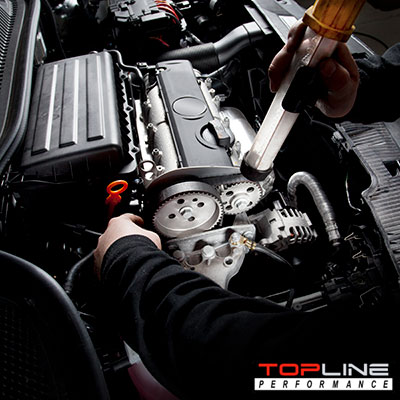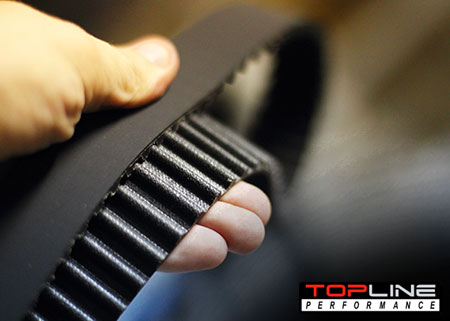Huntington Beach Timing Belt Replacement

While many car-related issues are known to owners, there is one that is sometimes overlooked but shouldn’t be: your timing belt. This is a hugely important part of your car, and it’s something that you’ll need to keep in mind to keep your car safe and running as it was supposed to. Below, we take a look at some of the key questions and issues surrounding your car’s timing belt. If you get your vehicles scheduled maintenance done at TopLine Performance, you’ll never have to worry because our technicians will be keeping an eye on it for you.
Call: (714) 477-7138
What does the timing belt do?
 To fully understand the importance of a timing belt, you need to know what it is. Essentially, this is the most important belt in the car’s engine. It’s responsible for opening and closing the valves for the pistons, which it does with an up and down movement. It’s called a timing belt because it performs its duties to precision; if it doesn’t work precisely, then it doesn’t work at all. It’s all about making sure that the valves and pistons talk to one another, and work in unison.
To fully understand the importance of a timing belt, you need to know what it is. Essentially, this is the most important belt in the car’s engine. It’s responsible for opening and closing the valves for the pistons, which it does with an up and down movement. It’s called a timing belt because it performs its duties to precision; if it doesn’t work precisely, then it doesn’t work at all. It’s all about making sure that the valves and pistons talk to one another, and work in unison.
When should it be replaced?
There’s no exact amount of time or amount of driven miles that dictates when the timing belt should be replaced. In general, however, experts recommend that it’s replaced somewhere in the region of every 60,000 – 100,000 miles. It differs from car to car, though, and in fact it should say how often it needs to be replaced in your vehicle’s manual. It’s important to note that this, of course, is just an estimate — your timing belt could fail before you hit the number of miles, or it could last a lot longer.
What if you don’t replace it?
If you don’t replace your timing belt, then you run the risk of it breaking. If that happens, then you could face severe issues with your engine; it might stop working altogether, and then you’d face an expensive repair. In some extreme cases, the cost of repairing this aspect of the car can mean it sometimes makes more sense to simply buy another car. However, that’s not usual. One of the main reasons why you should replace the timing belt on schedule is because the failure is all the same no matter whether it’s a complete snap of the belt, or if it’s just got a little bit of damage.
Can you drive with a faulty timing belt?
 It some cases, you can drive with a faulty timing belt, but if you do so, you’ll run the risk of causing even further damage. It’s a bit like walking when you’ve got a broken leg: you might technically be able to do it, but you’ll only make the break even worse. If you suspect that you have issues with your timing belt, then you’ll want to get it checked out by a professional as soon as possible. But of course, to do this you’ll need to be aware of the symptoms of timing belt issues.
It some cases, you can drive with a faulty timing belt, but if you do so, you’ll run the risk of causing even further damage. It’s a bit like walking when you’ve got a broken leg: you might technically be able to do it, but you’ll only make the break even worse. If you suspect that you have issues with your timing belt, then you’ll want to get it checked out by a professional as soon as possible. But of course, to do this you’ll need to be aware of the symptoms of timing belt issues.
There are some symptoms of a timing belt issue. You could notice an engine misfire, which will because of an engine cylinder that has opened and closed too quickly. A stalling engine is another sign that something that is up, too, as is rough idling of the engine.
Can you get it replaced early?
You don’t have to wait until you’ve reached the recommended amount of time before getting your timing belt checked out. If you drive your car a lot, and put it through difficult conditions, then it’s possible that your timing belt will face damage before you’ve reached the 60,000 – 100,000 miles mark. For peace of mind, you may want to get it replaced earlier. This is especially recommended if you’re planning a long trip, especially if you’re going to be driving thousands of miles. You’ll enjoy your trip much more if you know that everything under the hood is working as it should be.
How long will it take to replace?
 The timing belt is important, as we’ve already stated. But the actual job to replace it, while technically difficult, isn’t so time-consuming. If you face an issue with your timing belt and have to visit an auto repair shop for repairs, it’ll be a matter of days that you’re without your vehicle, rather than weeks. In fact, it’s possible that it could just be one day. The vast majority of cars will fall into that quick turnaround, though there are a few larger and specialized vehicles where it’ll take more time.
The timing belt is important, as we’ve already stated. But the actual job to replace it, while technically difficult, isn’t so time-consuming. If you face an issue with your timing belt and have to visit an auto repair shop for repairs, it’ll be a matter of days that you’re without your vehicle, rather than weeks. In fact, it’s possible that it could just be one day. The vast majority of cars will fall into that quick turnaround, though there are a few larger and specialized vehicles where it’ll take more time.
Do different cars have different timing belts?
Yes. While the general makeup of how a car works is more or less the same for all car producers, they do put their own spin on things, hence why some last for longer than others. And some don’t have a timing belt at all. For example, many modern cars don’t have a timing belt — they have a timing chain, which, as you may have imagined, is an upgrade on timing belts: they virtually never need replacing. But back to the cars that do have a timing belt: if you have an Acura, then you’re in luck — they’re the ones who have the longest period between changes. Ford vehicles are on the lower end; they recommend that car owners get theirs changed every 50,000 miles.
What if there’s additional damage?
It’s possible that additional damage could occur if the problem isn’t fixed right away, which will make fixing the vehicle more problematic and expensive. It’s always best to simply do as your car manual says, and don’t give your timing belt the chance to cause significant problems.

